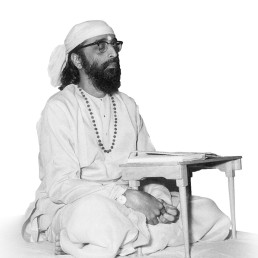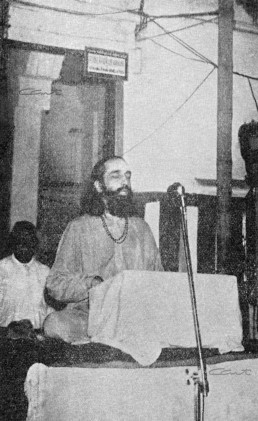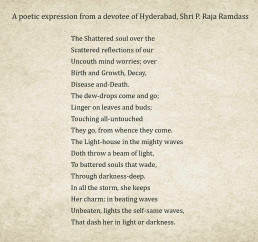
Jnana Yajna 25

Year & Dates:
December 16, 1956 to January 05, 1957

Yajna Topic:
Bhagavad Gita - Chapters 14 & 15

Place:
Hyderabad, India.
Hundred cities, 50,000 devotees, and the next stop, a silver milestone -the 25th Jnana Yajna at Hyderabad. On December 16, 1956, after a vibrant inauguration by the Andhra Pradesh Home Minister, Sri B. Gopal Reddy, and an uplifting hoisting of the Om flag by the Secretary for the 25th yajna, Rani Sarala Devi of Wanaparthy, the brimming crowd sat with alert anticipation in the Andhra Yuvati Mandali Hall, Barkatpura. Pujya Gurudev opened his yajna saying that the Gita was a handbook for the student who was eager to live with vigor and intensity, with inspiration and divinity.
Silver Milestone, Greater Journey
The handbook was available to all; so, for 21 days, Hindus, Muslims, Sikhs, Christians, and Parsees poured into the decorated hall, spilling over verandahs and nearby galleries. They listened riveted in amazement as Pujya Gurudev unfolded the fascinating varieties of life arising due to the play of Gunas; they strived to look within and around to detect the ropes of ‘mental moods’ that bind and influence the game of life. Then, Pujya Gurudev, with awe-inspiring eloquence, lifted their vision from the ever-changing to the changeless eternal substratum as indicated in the exalted Purushottama Yoga, chapter 15.
That momentous yajna where all aspects of Pujya Gurudev’s Jnana Yajna shone bright was also an important turning point in the history of Chinmaya Mission. With the guidance of Pujya Gurudev, the Constitution-making body of delegates from major branches of the Mission gathered to register and legalize Chinmaya Mission. They carefully framed the Memorandum of Association and Rules & Regulations for the sprouting branches of Chinmaya Mission. With a vision divine and a mission motivated, Pujya Gurudev’s Renaissance was in full steam. Hari Om and Hail Renaissance!
In Admiration
Rameshan of Hyderabad reflected: This, I consider to be the greatest trait of Swami Chinmayananda, viz.,that, he does not break one away from any line that one is pursuing all along, but acts as a catalytic agent, to intensify each one in his own particular line of saadhana. This is no mean achievement, inasmuch as, generally, Masters always insist that the disciple should surrender their adherence to everything else and follow their own prescribed course. But Swami Chinmayananda does not preach any particular method, but his dynamic presence is such that each one becomes stronger and abler in his own particular sadhana, and personal difficulties confronting one in his own line get clarified. He acts as a light to illuminate the paths for everyone going in different directions, and does not direct any one to any particular path.

“Think,” Says Pujya Gurudev
The term guna also means a rope, by which the spiritual beauty of life in us is tied down to the inert and insentient matter vestures. In short, gunas are the three different influences under which every human mind has to play in such an endless variety at different moments of its changing environments.
From Bhagavad Gita- Chapters 14, Book
The tree-of-multiplicity that has seemingly sprung forth from the Infinite Conscious Divine can be cut down by shifting our attention from the tree to the Divine.
From Bhagavad Gita- Chapters 15, Book
The Knowledge that transformed Narendra into Vivekananda!
Discover how the illumination of true wisdom transcends intellectual pursuits, leading to the awakening of consciousness beyond ego and worldly attachments. Witness the profound evolution of individuals into embodiments of divine truth, as exemplified by the journeys of Sri Ramakrishna and Swami Vivekananda. Experience the liberation from mental anxieties and the embrace of timeless consciousness with this enlightening discourse.


